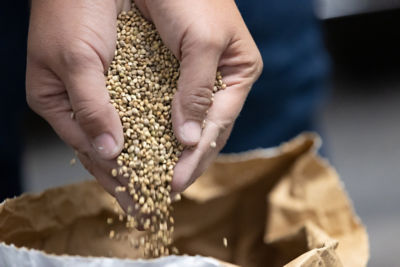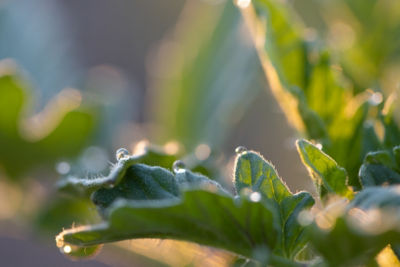Click here to download a PDF version of this spotlight.
» Powdery mildew of carrot can result in yield reductions when the disease is severe.
» The presence of powdery mildew on carrot tops can reduce the marketability of the crop.
» Powdery mildew can usually be managed by maintaining good plant vigor.
» Fungicide applications may be appropriate in some circumstances.
Powdery mildew of carrot is widely distributed, occurring wherever carrots are grown. In North America, powdery mildew of carrot is caused by the fungus Erysiphe heraclei. Other powdery mildew fungi occur on carrots in parts of Asia and Europe.1 The hosts of E. heraclei, include carrot, celery, anise, caraway, chervil, coriander, dill, fennel, parsley, parsnip, and many other species in the carrot family (Apiaceae). There may be some host specialization among the isolates of the powdery mildew fungus, but this has not been well established. The disease is most problematic in carrot-growing regions with Mediterranean-like climates. Powdery mildew can cause substantial reductions in yield when severe.
SYMPTOMS
Symptoms of powdery mildew tend to appear first on older tissues, typically on plants that are more mature and may not appear until at least seven weeks after planting.2 Symptoms typically develop seven to fourteen days after infection. The disease can develop on all above-ground parts of carrot plants, including leaflets, petioles, flower stalks, and umbels (Figures 1, 2, and 3).1 White, powdery lesions develop on the tissues. Older leaves and petioles can become covered with powdery, fungal growth, and the disease spreads from older to younger tissues. On younger leaves, small, circular white spots form initially (Figure 4).3,4 The spots enlarge, eventually covering large areas of the leaves. Infected leaves turn yellow and may senesce prematurely.
 Figure 1. Symptoms of Alternaria leaf blight. Gerald Holmes, Strawberry Center, Cal Poly San Luis Obispo, Bugwood.org.
Figure 1. Symptoms of Alternaria leaf blight. Gerald Holmes, Strawberry Center, Cal Poly San Luis Obispo, Bugwood.org.
 Figure 2. Petioles covered with hyphae and spores of the powdery mildew fungus. Gerald Holmes, Strawberry Center, Cal Poly San Luis Obispo, Bugwood.org.
Figure 2. Petioles covered with hyphae and spores of the powdery mildew fungus. Gerald Holmes, Strawberry Center, Cal Poly San Luis Obispo, Bugwood.org.
CYCLE AND CONDITIONS
The powdery mildew fungus overwinters on carrot plants and related hosts, including weed species.4 Powdery mildew spores are disseminated by the wind and can travel long distances (miles) to spread the disease. Powdery mildew of carrot is not known to be seedborne. High humidity levels favor the disease, but the spores do not need the presence of free moisture (wet leaves) to germinate and infect. In fact, rain and sprinkler irrigation can actually reduce disease severity. Powdery mildew develops best at moderate temperatures, between 55° and 90°F. The disease tends to be more severe in shaded conditions because the spores lose viability when exposed to the sun. The disease is also more severe on plants stressed by drought.
 Figure 3. Powdery mildew colonization of the umbel (flower cluster) of a carrot. Lindsey du Toit, Washington State University.
Figure 3. Powdery mildew colonization of the umbel (flower cluster) of a carrot. Lindsey du Toit, Washington State University.
MANAGEMENT
Management of powdery mildew on carrots begins with good water and fertility management practices to maintain good plant vigor. When irrigation is not available or feasible, the use of mulches can minimize the effects of drought conditions on carrot plants and reduce the severity of powdery mildew. Growers should provide adequate fertility, but avoid overfertilization that can lead to dense canopies and an abundance of lush, susceptible foliar tissue. Some carrot varieties are somewhat tolerant of powdery mildew.
Because powdery mildew often starts later in the season and the disease does not kill the affected tissue rapidly, fungicides are often not needed to protect yields. However, if carrots are marketed with their tops attached and the disease starts earlier in the season, or if it is severe, then fungicide applications may be appropriate. Sulfur-based fungicides and the biological control bacterium Bacillus subtilis can be used to manage powdery mildew on carrot and are approved for use in organic operations in the U.S.1,4 Several fungicides, including products containing azoxystrobin, pyraclostrobin, trifloxystrobin, and penthiopyrad are registered for control of carrot powdery mildew in conventional production systems.1,2
 Figure 4. Powdery mildew colonies developing on younger leaves.
Figure 4. Powdery mildew colonies developing on younger leaves.
SOURCES
1 Aegerter, B. 2002. Powdery mildew. In Compendium of Umbelliferous Crop Diseases. Davis, M. and Raid, R. editors. The American Phytopathological Society, St. Paul, MN.
2 McGrath, M. 2013. Powdery mildew on carrots. Cornell University. https://blogs.cornell.edu/livegpath/gallery/carrots/powdery-mildew-on-carrots/.
3 Wyenandt. A. 2021. Controlling fungal leaf blights of carrot. Plant & Pest Advisory. Rutgers University.
4 Nunez, J., Davis, R., Turini, T. 2009. How to manage pests: Carrot. UC Pest Management Guidelines. http://ipm.ucanr.edu/PMG/selectnewpest.carrots.html.
Websites verified 10/6/2021
ADDITIONAL INFORMATION
For additional agronomic information, please contact your local seed representative.
Performance may vary from location to location and from year to year, as local growing, soil and weather conditions may vary. Growers should evaluate data from multiple locations and years whenever possible and should consider the impacts of these conditions on the grower’s fields. The recommendations in this article are based upon information obtained from the cited sources and should be used as a quick reference for information about carrot production. The content of this article should not be substituted for the professional opinion of a producer, grower, agronomist, pathologist and similar professional dealing with this specific crop.
BAYER GROUP DOES NOT WARRANT THE ACCURACY OF ANY INFORMATION OR TECHNICAL ADVICE PROVIDED HEREIN AND DISCLAIMS ALL LIABILITY FOR ANY CLAIM INVOLVING SUCH INFORMATION OR ADVICE.
9054_SE_S2 Published 11-01-2021
Bayer, Bayer Cross Design, and Seminis® are registered trademarks of Bayer Group. All other trademarks are property of their respective owners. © 2021 Bayer Group. All rights reserved.



